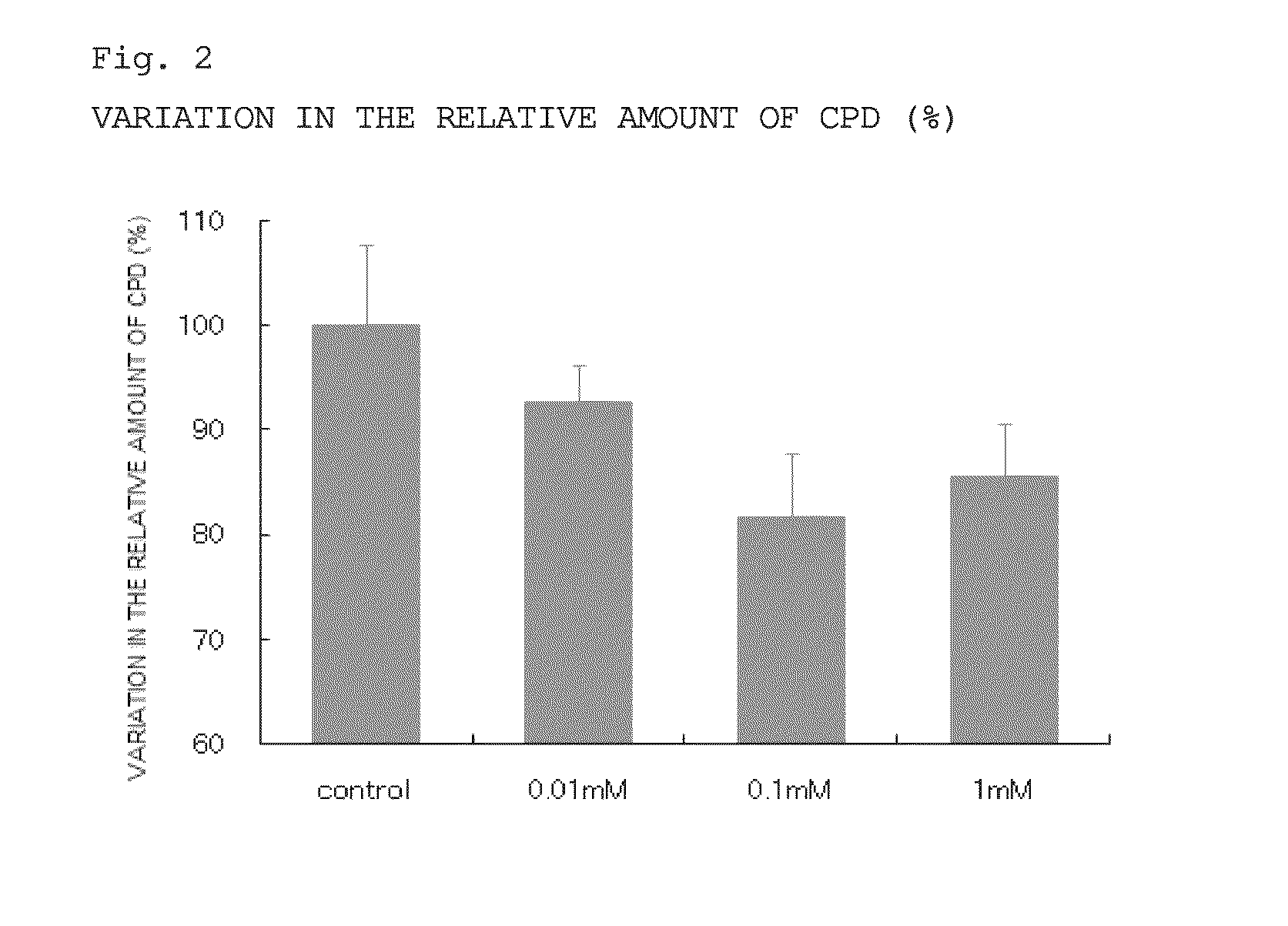Agent for suppressing the formation of abnormal skin cells caused by exposure to light
a technology of light-induced skin cells and agents, which is applied in the direction of biocide, dermatological disorders, drug compositions, etc., can solve the problems of increasing the incidence of skin cancer, unable to avoid the risk of forming abnormal skin cells, and affecting the normal development of skin cells, so as to reduce the amount of dna mutants in skin cells, effective preventive measures, and reduce the effect of dna mutants
- Summary
- Abstract
- Description
- Claims
- Application Information
AI Technical Summary
Benefits of technology
Problems solved by technology
Method used
Image
Examples
example 1
Action of Inducing Apoptosis in Mutant Cells Caused by Ultraviolet Irradiation
[0069]The present Example examined a change in the caspase activity when human epidermal cells treated with disodium adenosine 5′-monophosphate (AMP2Na) were irradiated with ultraviolet light.
[0070]
[0071]Human epidermal keratinocytes (purchased from Kurabo Industries Ltd.) were precultured using EpiLife-KG2 culture medium (produced by Kurabo Industries Ltd.) in 10 cm collagen-coated petri dishes (produced by Asahi Glass Co., Ltd.), and seeded at a density of 30,000 cells / well into a collagen-coated 96-well microplate. After cultivation in the EpiLife-KG2 culture medium for 8 hours, the culture medium was replaced with EpiLife culture medium (produced by Kurabo Industries Ltd.), followed by cultivation for an additional 16 hours. Subsequently, the culture medium was replaced with AMP2Na-containing culture medium adjusted to various concentrations. After treatment with the medium for 2 hours, the cells were ...
example 2
Evaluation of the Action of Reducing DNA Mutation Induced by Ultraviolet Irradiation
[0076]In this Example, normal mouse epidermal cells were irradiated with ultraviolet light, and then cultured in an AMP2Na-containing culture medium. Using the amount of cyclobutane pyrimidine dimers (CPD) as an index, the action of AMP2Na to reduce DNA mutation was examined.
[0077]
[0078]Normal mouse epidermal cell-derived JB6 cells (purchased from ATCC) were cultured in an FBS-containing MEM culture medium until subconfluent. Subsequently, 4×105 cultured cells were seeded into a 3.5 cm-dish with MEM (minimum essential medium) culture medium containing FBS (fetal bovine serum). Next day after the seeding, the culture medium was replaced with a serum-free MEM culture medium for serum starvation. Subsequently, the culture medium was replaced with PBS, followed by the irradiation with 15 mJ / cm2 of UV-B. After ultraviolet irradiation, the culture medium was replaced with serum-free MEM culture medium cont...
example 3
Evaluation of Preventive Effect on Skin Cancer in Ultraviolet Light-Irradiated Mice
[0085]In this Example, hairless mice were irradiated with ultraviolet light, and the preventive effect of AMP2Na against photocarcinogenesis in the mice was examined.
[0086]
[0087]5-week-old female Hos:HR-1 mice were purchased from Japan SLC, Inc., and from the age of 7 weeks, ultraviolet light (UV-B) irradiation was performed on their back. The ultraviolet irradiation (irradiation amount per time: 60 mJ / cm2) was performed once a day, 5 days a week, for 12 weeks.
[0088]Then, a 20% ethanol aqueous solution containing 3% of AMP2Na dissolved therein (test solution) and a 20% ethanol aqueous solution containing no AMP2Na (base) were prepared.
[0089]After feeding the ultraviolet light-irradiated mice under normal conditions for 1 week, the mice were divided into 3 groups (6 mice in each group) under the conditions shown in Table 1, and fed for 12 weeks.
[0090]
TABLE 1Test ConditionsTest solution-Test solution (0...
PUM
| Property | Measurement | Unit |
|---|---|---|
| temperature | aaaaa | aaaaa |
| time | aaaaa | aaaaa |
| time | aaaaa | aaaaa |
Abstract
Description
Claims
Application Information
 Login to View More
Login to View More - R&D
- Intellectual Property
- Life Sciences
- Materials
- Tech Scout
- Unparalleled Data Quality
- Higher Quality Content
- 60% Fewer Hallucinations
Browse by: Latest US Patents, China's latest patents, Technical Efficacy Thesaurus, Application Domain, Technology Topic, Popular Technical Reports.
© 2025 PatSnap. All rights reserved.Legal|Privacy policy|Modern Slavery Act Transparency Statement|Sitemap|About US| Contact US: help@patsnap.com



